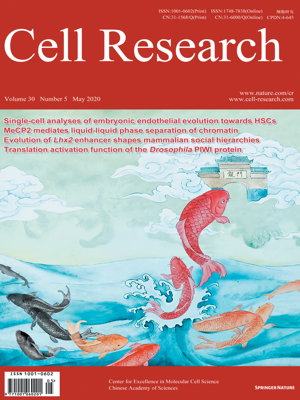
Advanced Search
Submit Manuscript
Advanced Search
Submit Manuscript
Volume 30, No 5, May 2020
ISSN: 1001-0602
EISSN: 1748-7838 2018
impact factor 17.848*
(Clarivate Analytics, 2019)
Volume 30 Issue 5, May 2020: 408-420
Accelerated evolution of an Lhx2 enhancer shapes mammalian social hierarchies
Yuting Wang1,2,† , Guangyi Dai1,† , Zhili Gu1,† , Guopeng Liu1,2,† , Ke Tang3 , Yi-Hsuan Pan4 , Yujie Chen5 , Xin Lin1,2 , Nan Wu4 , Haoshan Chen2,6 , Su Feng2,7 , Shou Qiu2,6 , Hongduo Sun1,2 , Qian Li1 , Chuan Xu1 , Yanan Mao2,8 , Yong Edward Zhang2,8,9 , Philipp Khaitovich1,9 , Yan-Ling Wang10 , Qunxiu Liu11 , Jing-Dong Jackie Han1 , Zhen Shao1 , Gang Wei1 , Chun Xu6 , Naihe Jing7 , Haipeng Li1,9,*
1CAS Key Laboratory of Computational Biology, CAS-MPG Partner Institute for Computational Biology, Shanghai Institute of Nutrition and Health, Chinese Academy of Sciences, Yueyang Road 320, 200031 Shanghai, China;Social hierarchies emerged during evolution, and social rank influences behavior and health of individuals. However, the evolutionary mechanisms of social hierarchy are still unknown in amniotes. Here we developed a new method and performed a genome-wide screening for identifying regions with accelerated evolution in the ancestral lineage of placental mammals, where mammalian social hierarchies might have initially evolved. Then functional analyses were conducted for the most accelerated region designated as placental-accelerated sequence 1 (PAS1, P = 3.15 × 10−18). Multiple pieces of evidence show that PAS1 is an enhancer of the transcription factor gene Lhx2 involved in brain development. PAS1s isolated from various amniotes showed different cis-regulatory activity in vitro, and affected the expression of Lhx2 differently in the nervous system of mouse embryos. PAS1 knock-out mice lack social stratification. PAS1 knock-in mouse models demonstrate that PAS1s determine the social dominance and subordinate of adult mice, and that social ranks could even be turned over by mutated PAS1. All homozygous mutant mice had normal huddled sleeping behavior, motor coordination and strength. Therefore, PAS1-Lhx2 modulates social hierarchies and is essential for establishing social stratification in amniotes, and positive Darwinian selection on PAS1 plays pivotal roles in the occurrence of mammalian social hierarchies.
https://doi.org/10.1038/s41422-020-0308-7